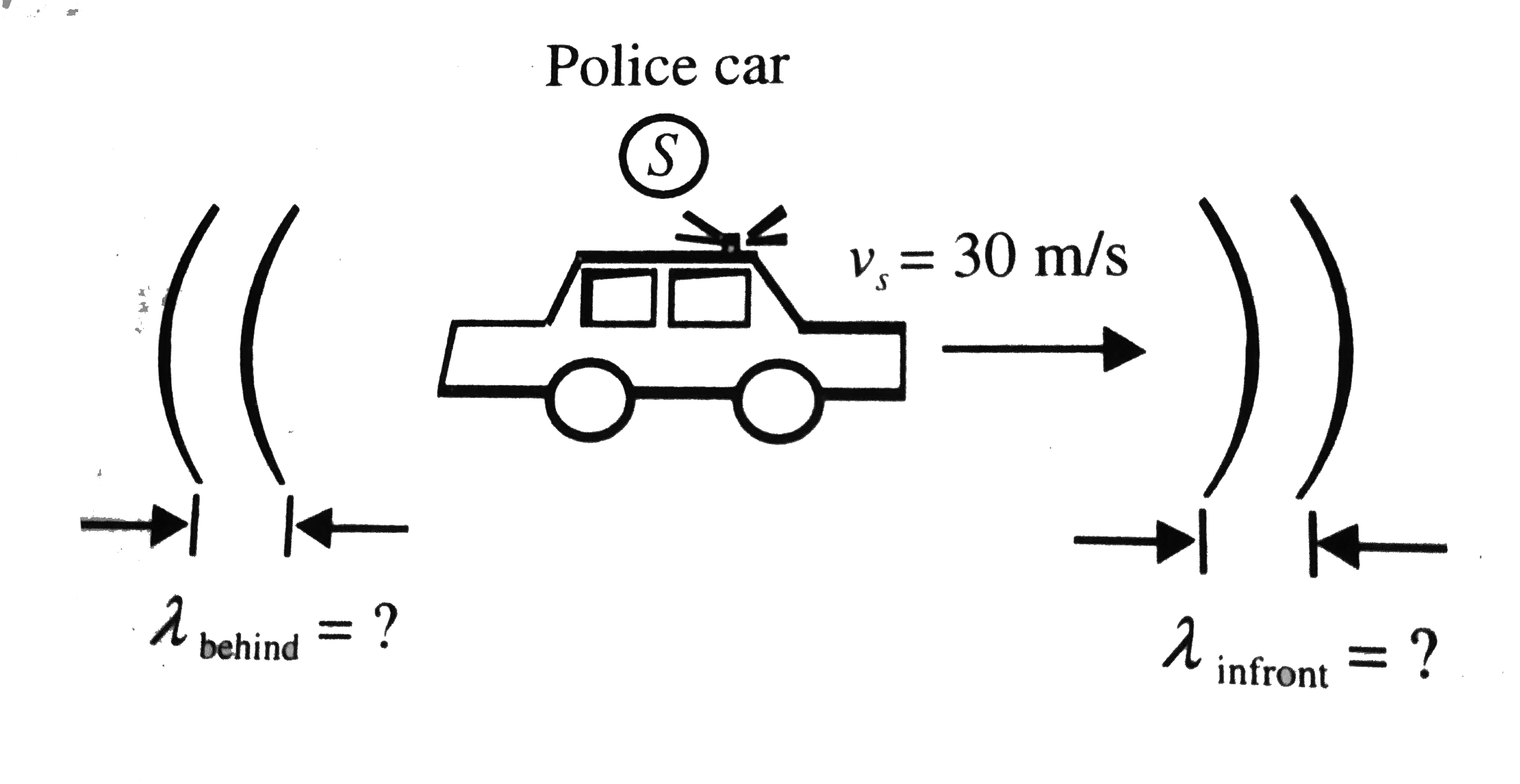A police siren emits a sinusoidal wave with frequency fs=300Hz the speed of sound is 340ms. (a) find the wavelength of waves if the siren is at rest in the air. (b) If the siren is moving at 30ms, then find the wavelength of the waves is front of and behind the source.

The doppler effect is not involved in part (a), since neither the source nor the listener is moving. In part (b), the source is in motion and we must involve the doppler effect. Figure. Shows the situation .We use the relation ship v=λf
to determine the wavelength when the polive siren is at rest When it is in motion, we find the wavelength on either side of siren.
a. When the source is at rest,
λ=vfS=340ms300Hz=1.13m
b. The situation is shown in Fig. Now, in front of the siren,
λ∈ont=v−vSfS=340ms−30ms300Hz=1.03m
Behind the siren,
λbeh∈d=v+vSfS=340ms+30ms300Hz=1.23m
The wavelength is less in front of the siren and greater behind the siren, as it should be.
Topper's Solved these Questions
- BOOK - CENGAGE PHYSICSCHAPTER - SOUND WAVES AND DOPPLER EFFECTEXERCISE - Examples56videos
SOUND WAVES AND DOPPLER EFFECT
- BOOK - CENGAGE PHYSICSCHAPTER - SOUND WAVES AND DOPPLER EFFECTEXERCISE - Exercise 6.156videos
SOUND WAVES AND DOPPLER EFFECT
- BOOK - CENGAGE PHYSICSCHAPTER - RIGID BODY DYNAMICS 2EXERCISE - Interger2videos
RIGID BODY DYNAMICS 2
- BOOK - CENGAGE PHYSICSCHAPTER - SUPERPOSITION AND STANDING WAVESEXERCISE - Comprehension Type5videos
SUPERPOSITION AND STANDING WAVES
Similar Questions
A police siren emits a sinusoidal wave with frequency fS=300Hz . The speed of the sound is 340m/s. (a) Find the wavelength of the waves if siren is at rest in the air . (b) If the siren is moving at 30m/s, Find the wavelength of the waves ahead of and behind the source.
View SolutionA body is vibrating 6000 times in 1 min. If the velocity of sound in air is 300 m s−1, find the wavelength of the wave.
View Solution
Knowledge Check
- Question 1 - Select One
If the frequency of a wave is 330 Hz, and velocity of wave in air is 330 m s−1, then, the wavelength of the wave is
A0.5 mB1 mC2 mDnot certain - Question 2 - Select One
A sound wave of wavelength 90 cm in glass is refracted into air. If the velocity of sound in glass is 5400 m/s, then wavelength of the wave in air is
A55 cmB5.5 cmC55 mD5.5 m - Question 3 - Select One
A fire whistle emits a tone of 170 Hz. Take the speed of sound in air to be 340 m/s. The wavelength of this sound is about
A0.5mB1.0mC2.0mD3.0m
A plice siren emits a sound wave of frequency 440 Hz. The speed of sound is 332 m/s. if the siren is moving away from the listerner with a speed of 18 m/s relative to the air and the listerner is moving towards the siren with a speed of 68 m/s relative to the air, then what frequency does the listern hear?
View SolutionA police siren emits a sound wave of frequency 440 Hz. The speed of sound is 332 m/s. if the siren is moving away from the listerner with a speed of 18 m/s relative to the air and the listerner is moving towards the siren with a speed of 68 m/s relative to the air, then what frequency does the listern hear?
View SolutionThe speed of sound in sea water is 1530m/s. The wavelength of a wave transmitted through the sea is 0.02m. Find its frequency.
View SolutionSound waves travel with a speed of about 330m/s. what is the wavelength of sound whose frequency is 550 hertz?
View SolutionA stationary police car sounds a siren with a frequency of 990 Hz. If the speed of sound is 330 m/s, an observer, driving towards the car with a speed of 33 m/s, will hear a frequency of
View Solution

